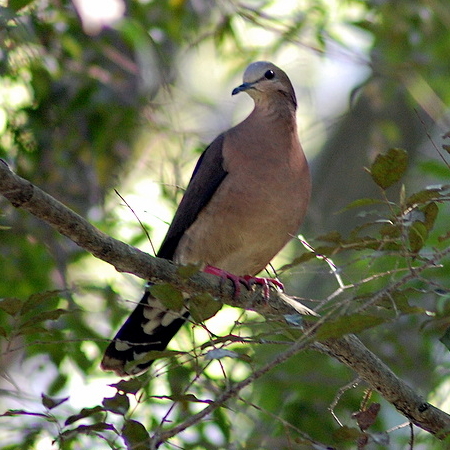- Grey-fronted Dove
Taxobox
name = Grey-fronted Dove

status = LC | status_system = IUCN3.1
regnum =Animal ia
phylum = Chordata
classis = Aves
ordo =Columbiformes
familia =Columbidae
genus = "Leptotila "
species = "L. rufaxilla"
binomial = "Leptotila rufaxilla"
binomial_authority = (Richard and Bernard,1792 )The Grey-fronted Dove, ("Leptotila rufaxilla") is a large
New World tropicaldove . It is a resident breeder inSouth America fromColombia ,Venezuela and theGuyanas south to northeastArgentina andUruguay . Severalsubspecies exist, among them "L. r. hellmayrii" fromTrinidad and theParia Peninsula inVenezuela .The
Grey-headed Dove , "Leptotila plumbeiceps", ofCentral America and theGrenada Dove , "L. wellsi", ofGrenada were formerly considered conspecific with Grey-fronted Dove.The Grey-fronted Dove inhabits humid forest and woodland. It builds a large stick nest in a bush or on a stump and lays two white eggs.
The Grey-fronted Dove is very similar to the closely related
White-tipped Dove , "Leptotila verreauxi", which, in the area of overlap, prefers more open, drier, woodland.It has an approximate length of 28 cm (11 in) and a weight of 155 g (5½ oz). Adult have a blue-grey crown, a whitish forehead and a grey neck showing purple iridescence. They have a whitish throat and the eye-ring is red. The upperparts and wings are grey-brown, and the underparts are whitish shading to pinkish-buff on the chest. The underwing coverts are rufous. The white tip to the tail is narrower than in the White-tipped Dove. The bill is black, the legs red and the iris is yellow. "L. r. hellmayrii" has a paler forehead and darker, more rufous, breast.
It is best distinguished from the White-tipped Dove by the buffier lower face and the more contrasting, bluish-grey crown. Another feature is the red (not blue) eye-ring of the Grey-fronted Dove, but this is not reliable in all parts of
Brazil , Argentina,Bolivia ,Paraguay and Uruguay, where it typically is red in both.The Grey-fronted Dove is usually seen singly or in pairs, and is rather wary. Its flight is fast and direct, with the regular beats and clattering of the wings which are characteristic of pigeons in general.
The food of this species is mainly seeds obtained by foraging on the ground, but it will also take
insect s. The call is a deep hollow "ooo-wooooo-ou".References
* Database entry includes justification for why this species is of least concern
*cite book
last = Hilty
first = Steven L
title = Birds of Venezuela
publisher = Christopher Helm
date = 2003
location = London
isbn = 0-7136-6418-5
*cite book
last = ffrench
first = Richard
title = A Guide to the Birds of Trinidad and Tobago
edition = 2nd edition
year = 1991
publisher = Comstock Publishing
isbn = 0-8014-9792-2External links
* [http://ibc.hbw.com/ibc/phtml/especie.phtml?idEspecie=1855 Grey-fronted Dove videos] on the Internet Bird Collection
* [http://www.bird-stamps.org/cspecies/7213500.htm Stamps] (forSuriname ) with RangeMap
* [http://vireo.acnatsci.org/search.html?Form=Search&SEARCHBY=Common&KEYWORDS=gray-fronted+dove&showwhat=images&AGE=All&SEX=All&ACT=All&Search=Search&VIEW=All&ORIENTATION=All&RESULTS=24 "Gray-fronted Dove" photo gallery] VIREO [http://vireo.acnatsci.org/species_image.php?species=Leptotila+rufaxilla Photo-High Res]
* [http://www.terrabrasil.org.br/ecosistema/fotos/aves05/juriti.jpgPhoto-High Res] ; [http://www.terrabrasil.org.br/ecosistema/ecosist_aves1.htm Article] terrabrasil
* [http://www1.nhl.nl/~ribot/jpg10/leru_nt.jpgPhoto-Medium Res] ; [http://www1.nhl.nl/~ribot/english/leru_ng.htm Article, Map & synopsis] www1.nhl.nl—Doves in Suriname
Wikimedia Foundation. 2010.
